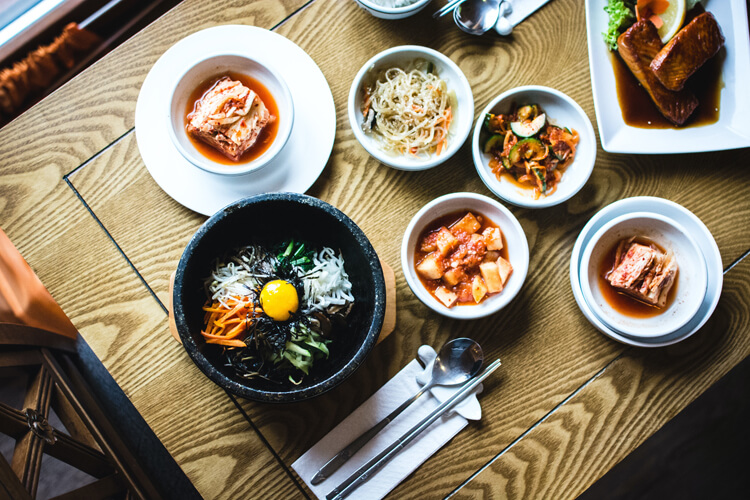With Korean-American Day here at last, it seems only fitting to celebrate our beloved brothers and sisters of Korean descent by sharing a little-known fact about Korean cuisine. Thanks to centuries of Korean ingenuity, recent research reveals that Korean food health benefits go well beyond the scope of essential nutrients. Two of America’s favorite Korean dishes—kimchi and cheonggukjang—are in the spotlight today as we celebrate Korean-Americans and their anti-fungal contributions to this great nation’s diverse menu!
Happy Korean-American Day!
The journey and integration of the first 100+ Koreans to the United States of America in 1903 was arduous and rife with hardship, but their courage and their foresight to make this country their home has enriched American culture (and diet!) for over 118 years.
The Korean-American story is a fascinating one and further learning of their history and experience is highly encouraged. For additional information, please check out the following links:
National Today’s spotlight on Korean-American Day
KEI’s Virtual Celebration of Korean-American Day
The National Association of Korean-Americans
By clicking on these links, you are not only acknowledging the significance of Korean-American Day, you are also enhancing your understanding of their struggle and important impact on American society. Please wish your Korean brothers and sisters a “Happy Korean-American Day!” and feel free to share additional links and information regarding Korean-American history and Korean food culture in the comments below.
Korean Food Health Benefits
While I look forward to possible discussions on Korean-American Day in the comment section, we must first get down to the business of mold talk—after all, this is MoldBlogger. Today, I am excited to share with you the anti-fungal properties of America’s two favorite Korean dishes—kimchi and cheonggukjang!
It may come as a surprise to many MoldBlogger readers that the spotlight falls on fermented Korean food health benefits, considering there have been two anti-fungal diet do’s and don’ts articles in the past that mention the fungal-risk of fermented foods. However, recent research suggests there may be an exception to this rule which would allow mold-sufferers and lovers of Korean dishes to indulge guilt- and mold-free on this special day!
Is Korean Food Good for You?
Before we touch on the anti-fungal properties of kimchi and cheonggukjang, let’s delve into the beauty and health benefits of the Korean cuisine as a whole.
While the vast majority of Koreans are not vegetarian, the Korean diet itself boasts a significant inclusion of vegetables into nearly every dish. With the Standard American Diet (affectionately coined “S.A.D.”) consisting of mostly processed carbohydrates and mold-infested grains, it is safe to say that Korean food influences upon American society are much-needed and should rightly be a part of the Korean-American Day celebrations.
It may be true that international vegetables have infiltrated Korean dishes for over 100 years now, but the staple of Korean food recipes revolves around vegetables native to Asia, such as cabbages, radishes, spinach, peppers, and bean sprouts.
Because all vegetables and spices contain anti-fungal properties, a Korean diet containing spices and over 2/3s vegetables is less likely to allow exposure to mold or exacerbate mold toxicity symptoms, which makes many Korean dishes an acceptable diet for today’s festivities if you are concerned about a current mold-induced condition.
What is Kimchi?
One of the most popular Korean dishes in America is kimchi. Kimchi can act as both an entrée and an appetizer. Traditionally, Koreans enjoy kimchi with every meal, even breakfast.
Kimchi is comprised of vegetables (cabbage, radishes, etc.), garlic, ginger, chili peppers, salt, and a sauce base—usually fish sauce, but there are vegan alternative recipes that use a soy sauce and nori (seaweed) base for the same “ocean” flavor.
Because of its unique preparation and fermenting process, kimchi’s greatest health benefit is its abundance of probiotics, namely those of the Lactobacillus family. Kimchi offers millions of distinct varieties of live microbes, unlike most of the probiotic supplements you can buy online or at your local store. While not unhelpful, many probiotic supplements tend to consist of a monocrop of probiotic strains, which lack the ideal variety for optimal gut health that kimchi provides.
Because of its ingredients and fermentation process, kimchi is hailed as one of the most health-beneficial Korean dishes thanks to its anti-fungal and anti-inflammatory properties.
What is Cheonggukjang?
Cheonggukjang (chun-yük-jang) is a thick paste made from fermented soybeans and red chili powder. Popular in Korea and Korean-American cuisine, this paste is used to flavor stews full of vegetables and oftentimes tofu, among other ingredients. It has an umami taste to it, which is the Japanese term that means a rich “savoriness.”
There is a common saying about cheonggukjang: “You either hate it or love it, there is no in between.” This is certainly true of cheonggukjang, as it has a range and depth of flavor similar in intensity to other pastes and broths like miso and doenjang.
What does cheonggukjang have in common with kimchi? Just like kimchi, this spicy paste undergoes a fermenting process that breeds the same gut-beneficial strains of probiotics, making it kimchi’s equal when it comes to fermented Korean food health benefits.
What Exactly Makes Kimchi and Cheonggukjang Anti-Fungal?
A recent scientific article—“Healthy and Safe Korean Traditional Fermented Foods: Kimchi and Chongkukjang”—concluded that not only were these two fermented goodies capable of effectively inhibiting the growth of foodborne pathogens, they also contained within them very special anti-fungal strains of bacteria—Lactobacillus plantarum, L. cruvatus, L. lactis, L. casei, L. pentosus, L. acidophilus, and L. sake—and acidic properties that render dangerous microscopic mold spores ineffective and unable to grow and colonize.
Overall, these types of studies reveal that kimchi and cheonggukjang are not only anti-fungal, they’re anti-inflammatory, anti-bacterial, anti-oxidant, anti-cancer, anti-obesity, and anti-aging, as well.
In Conclusion
Thankfully, those suffering from mold-induced conditions now have two fermented foods they can enjoy without worrying about further mold exposure and aggravation. In other words, pass the kimchi! Break out the cheonggukjang! It’s time—and perfectly safe!—to celebrate Korean-American Day!
For more information regarding mold, mold prevention, and mold solutions, please check out the rest of MoldBlogger.com.
About the Author: Amanda Demsky is the mother and personal chef of two boys, the domestic technician of a desert home, and occasionally, a freelance writer and editor. If you have questions regarding this topic or suggestions for related topics, please feel free to comment below to receive a direct response from the author herself.


